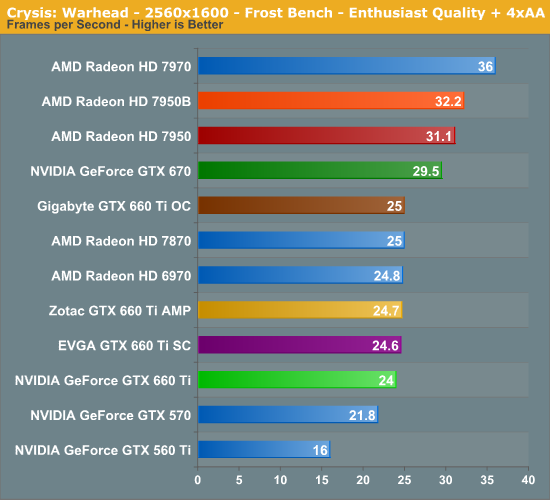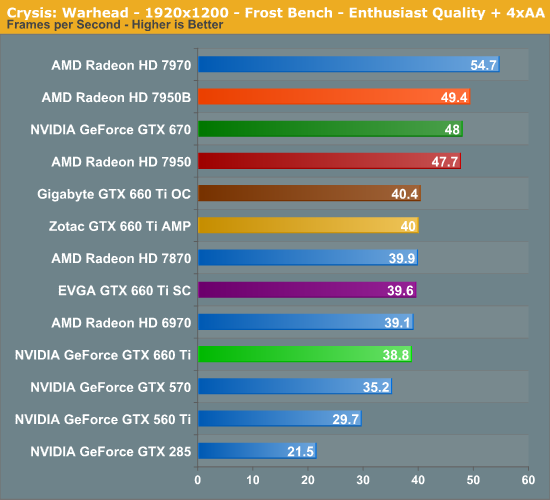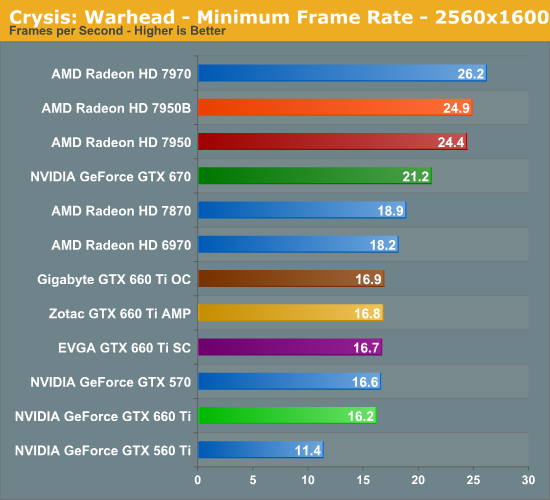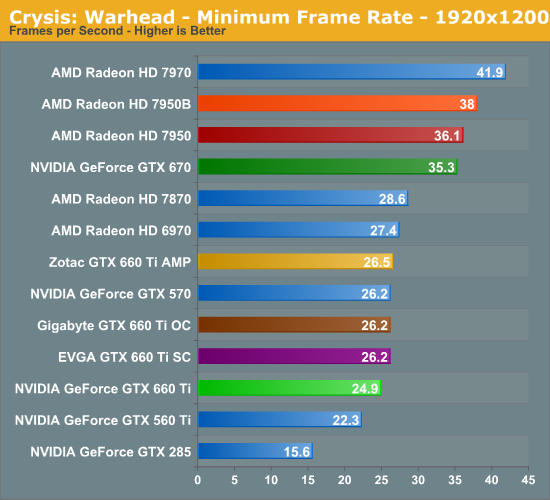The GeForce GTX 660 Ti Review, Feat. EVGA, Zotac, and Gigabyte
by Ryan Smith on August 16, 2012 9:00 AM ESTCrysis: Warhead
Kicking things off as always is Crysis: Warhead. It’s no longer the toughest game in our benchmark suite, but it’s still a technically complex game that has proven to be a very consistent benchmark. Thus even four years since the release of the original Crysis, “but can it run Crysis?” is still an important question, and the answer continues to be “no.” While we’re closer than ever, full Enthusiast settings at a 60fps is still beyond the grasp of a single-GPU card.


For a $300 performance card the most important resolution is typically going to be 1920x1080/1200, however in some cases these cards should be able to cover 2560x1440/1600 at a reasonable framerate. To that end, we’ll be focusing on 1920x1200 for the bulk of our review.
Crysis has been a sore spot for NVIDIA since the launch of Kepler, and GTX 660 Ti doesn’t improve this. Since it’s a memory bandwidth constrained game and GTX 660 Ti takes away 25% of GK104’s memory bandwidth, the result is a predictable drop in performance. The GTX 660 Ti only reaches 80% of the GTX 670’s performance here, which is only a bit more than our worst case scenario of 75%. At 38.8fps it’s playable, but it’s definitely not a great experience. So for anyone wanting to partake in this classic, an AMD card is the way to go and it doesn’t matter which; even the 7870 is marginally faster.
As for our factory overclocked cards from Zotac, EVGA, and Gigabyte, while they improve the situation they don’t do so by a great deal. Unexpectedly, despite its memory bandwidth advantage the Gigabyte card actually edges out the Zotac card here, due to the former’s higher power target allowing it to boost to higher clockspeeds. Still that’s only a 4% improvement, far below what these kinds of overclocks are really capable of hitting.


Looking at minimum framerates is even more grim; the GTX 660 Ti is experiencing its worst case scenario. Crysis, Kepler, and low memory bandwidth are a very bad combination here. As for the factory overclocked cards, the Zotac card finally takes the lead thanks to its memory overclock, but like our average framerates in Crysis it’s not a particularly big jump.










313 Comments
View All Comments
Oxford Guy - Thursday, August 16, 2012 - link
What is with the 285 being included? It's not even a DX 11 card.Where is the 480? Why is the 570 included instead of the 580?
Where is the 680?
Ryan Smith - Saturday, August 18, 2012 - link
The 285 was included because I wanted to quickly throw in a GTX 285 card where applicable, since NVIDIA is promoting the GTX 660 Ti as a GTX 200 series upgrade. Basically there was no harm in including it where we could.As for the 480, it's equivalent to the 570 in performance (eerily so), so there's never a need to break it out separately.
And the 680 is in Bench. It didn't make much sense to include a card $200 more expensive which would just compress the results among the $300 cards.
CeriseCogburn - Sunday, August 19, 2012 - link
So you're saying the 680 is way faster than the 7970 which you included in every chart, since the 7970 won't compress those $300 card results.Thanks for admitting that the 7970 is so much slower.
Pixelpusher6 - Friday, August 17, 2012 - link
Thanks Ryan. Great review as always.I know one of the differentiating factors for the Radeon 7950s is the 3GB of ram but I was curious are there any current games which will max out 2GB of RAM with high resolution, AA, etc.?
I think it's interesting how similar AMDs and Nvidias GPUs are this generation. I believe Nvidia will be releasing the GTX 660 non Ti based on GK106. Leaked specs seem to be similar to this card but the texture units will be reduced to 64. I wonder how much of a performance reduction this will account for. I think it will be hard for Nvidia to get the same type of performance / $ as say GTX 460 / 560 Ti this generation because of having to have GK104 fill in more market segments.
Also I wasn't aware that Nvidia was still having trouble meeting demand with GK104 chips I thought those issues were all cleared up. I think when AMD released their 7000 series chips they should have taken advantage of being first to market and been more competitive on price to grow market share rather than increase margins. At that time someone sitting on 8800GT era hardware would be hard pressed to upgrade knowing that AMDs inflated prices would come down once Nvidia brought their GPUs to market. People who hold on to their cards for a number of years is unlikely to upgrade 6 months later to Nvidias product. If AMD cards were priced lower at this time a lot more people would have bought them, thereby beating Nvidia before they even have a card to market. I do give some credit to AMD for preparing for this launch and adjusting prices, but in my opinion this should have been done much earlier. AMD management needs to be more aggressive and catch Nvidia off guard, rather than just reacting to whatever they do. I would "preemptively" strike at the GTX 660 non Ti by lowering prices on the 7850 to $199. Instead it seems they'll follow the trend and keep it at $240-250 right up until the launch of the GTX 660 then lower it to $199.
Ryan Smith - Saturday, August 18, 2012 - link
Pixelpusher, there are no games we test that max out 2GB of VRAM out of the box. 3GB may one day prove to be advantageous, but right even at multi-monitor resolutions 2GB is doing the job (since we're seeing these cards run out of compute/render performance before they run out of RAM).Sudarshan_SMD - Friday, August 17, 2012 - link
Where are naked images of the card?CeriseCogburn - Thursday, August 23, 2012 - link
You don't undress somebody you don't love.dalearyous - Friday, August 17, 2012 - link
it seems the biggest disappointment i see in comments is the price point.but if this card comes bundled with borderlands 2, and you were already planning on buying borderlands 2 then this puts the card at $240, worth it IMO.
rarson - Friday, August 17, 2012 - link
but it's the middle of freaking August. While Tahiti was unfortunately clocked a bit lower than it probably should have been, and AMD took a bit too long to bring out the GE edition cards, Nvidia is now practically 8 months behind AMD, having only just released a $300 card. (In the 8 months that have gone by since the release of the 7950, its price has dropped from $450 to $320, effectively making it a competitor to the 660 Ti. AMD is able to compete on price with a better-performing card by virtue of the fact that it simply took Nvidia too damn long to get their product to market.) By the time the bottom end appears, AMD will be ready for Canary Islands.It's bad enough that Kepler (and Fermi, for that matter) was so late and so not available for several months, but it's taking forever to simply roll out the lower-tier products (and yes, I know 28nm wafers have been in short supply, but that's partially due to Nvidia's crappy Kepler yields... AMD have not had such supply problems). Can you imagine what would have happened if Nvidia actually tried to release GK110 as a consumer card? We'd have NOTHING. Hot, unmanufacturable nothing.
Nvidia needs to get their shit together. At the rate they're going, they'll have to skip an entire generation just to get back on track. I liked the 680 because it was a good performer, but that doesn't do consumers any good when it's 4 months late to the party and almost completely unavailable. Perhaps by the end of the year, 28nm will have matured enough and Nvidia will be able to design something that yields decently while still offering the competitiveness that the 680 brought us, because what I'd really like to see is both companies releasing good cards at the same time. Thanks to Fermi and Kepler, that hasn't happened for a while now. Us consumers benefit from healthy competition and Nvidia has been screwing that up for everyone. Get it together, Nvidia!
CeriseCogburn - Sunday, August 19, 2012 - link
So as any wacko fanboy does, you fault nVidia for releasing a card later that drives the very top end tier amd cards down from the 579+ shipping I paid to $170 less plus 3 free games.Yeah buddy, it's all nVidia's fault, and they need to get their act together, and if they do in fact get their act together, you can buy the very top amd card for $150, because that's likely all it will be worth.
Good to know it's all nVidia's fault. AMD from $579+plus ship to $409 and 3 free games and nVidia sucks for not having it's act together.
The FDA as well as the EPA should ban the koolaid you're drinking.